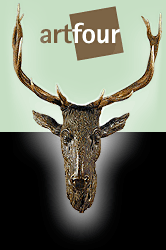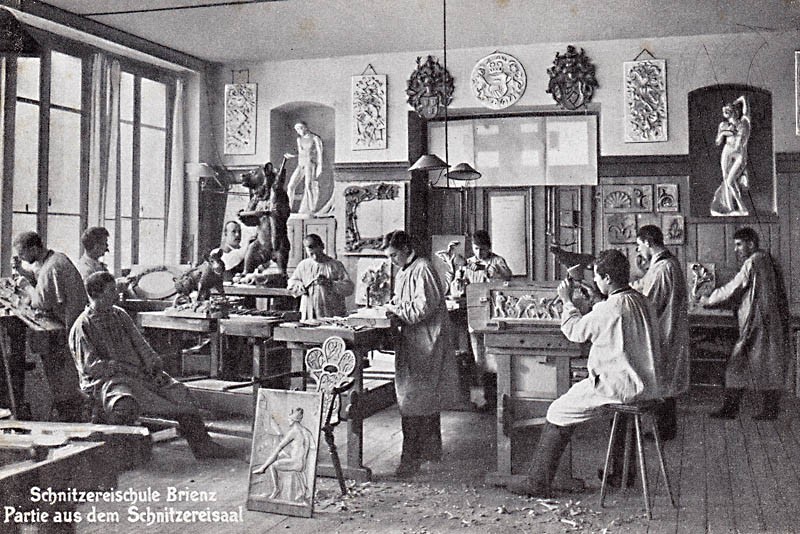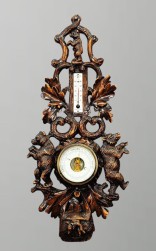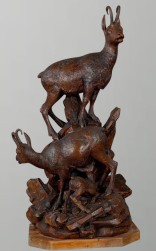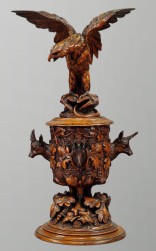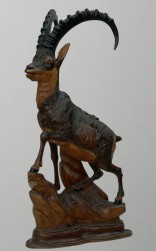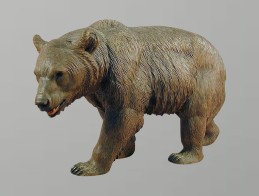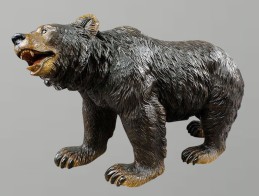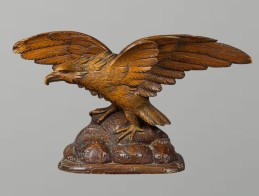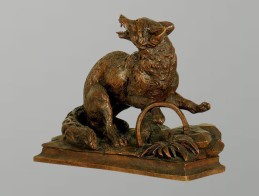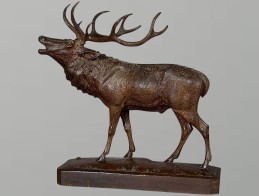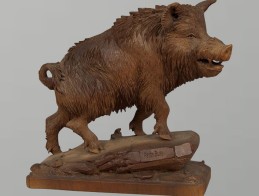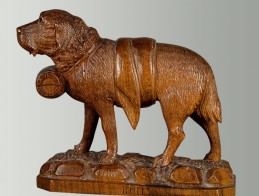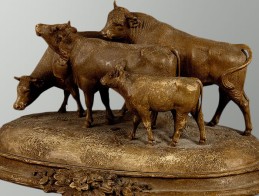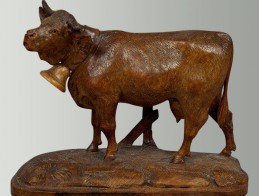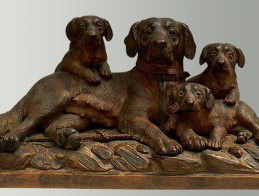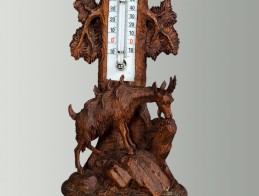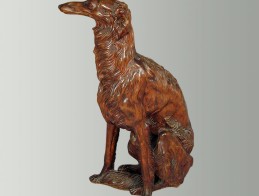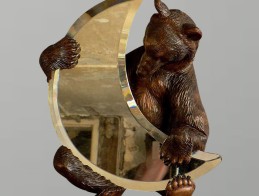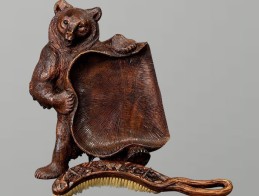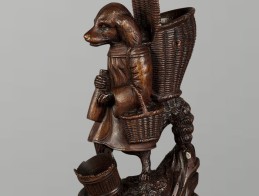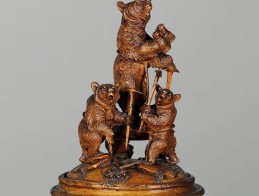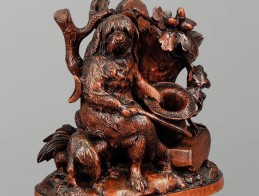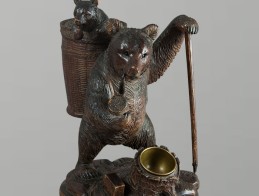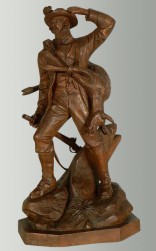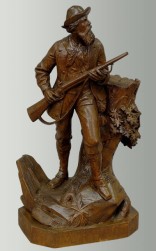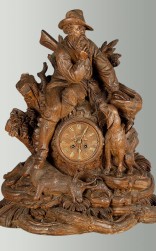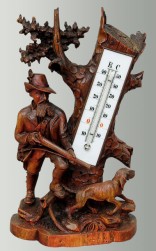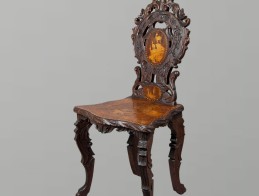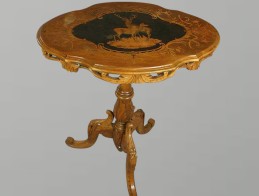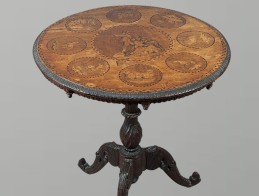About Brienz (black forest) wood carvings
History
The idea behind the marvelous success of Brienz wood carving was quite simple. After a disastrous famine in 1816 in the Brienz area people were forced to find new areas of revenues. Driven by the need to create jobs in the Bernese Oberland, an economically underdeveloped region, the Swiss government encouraged the existing resource of timber industry to liaise with the traditional wooden craftsmanship. It took some time to improve from home requirements to sophisticated desigend arts but the process was supported by the rising amount of tourists visiting the region.
City of Brienz
Brienz is located at the head eastern end of the Lake Brienz, at the foot of the mountain Rothorn (2350m a.s.l.) and nestling between the triangle of the cantons of Bern, Luzern and Oberwalden. Its geographical position offers Brienz a favorable climate throughout the year and the permanent varying atmosphere of the lake appears as an extraordinary experience to its visitors. The ancient trade routes from Northern to Southern Europe followed alongside the surrounding alpine passes and nowadays it also takes only a couple of minutes to reach the Brienz-Rothorn mountain railway, the Brünig Railway station and the fleets of ships of boat excursions on the Lake Brienz. The narrow gauge route operated by Zentral Railways runs from the famous cities of Interlaken, Meiringen-Hasliberg, Brünig, Luzern and Engelberg. From the valley station of Brienz a steam cog railway discovers the beautyful mountain region of Rothorn. Boat excursions from Interlaken on Lake Brienz end in the city of Brienz. The "Brunngasse" with its ornamental carved houses from the 18th century is known internationally and was once awarded the prize of the most beautiful alleyway of Europe. The open-air museum Ballenberg provides an insight into the Swiss living from the 16th to the 19th century.
The Gran Tour Tourism
The Gran Tour was a well-known trip to European cultural centers and in former times a standard feature of the education of the young European upper-class people. Later on this tradition was extended to U.S. and South American people as well as European middle-class. It was believed that the value of such a trip lay in the exposure both to the cultural legacy of classical antiquity and the Renaissance and to the aristocratic and fashionably polite society of the European continent. In addition, it provided the only opportunity to view specific works of art and possibly the only chance to hear certain music. A Gran Tour could last from several months to several years. Especially the British nobility was known for art trendsetting and the collection of extra ordinary souvenirs became very popluar. Brienz, Interlaken and Luzern together with other resorts in that area were in vogue with the wealthy Victorians. Some business-minded craftsmen like Christian Fischer realized the increasing importance of tourists for future business.
Christian Fischer and other founders
Christian Fischer (1790-1848) started self-taught from simple turneries (carved bowls and other article of daily use) to unsophisticated regional animals and people. Due to his success and the interest of the tourists other carvers started also following his idea of carving the pristine naturalism. The Swiss government supported these start-ups with additional trainings of apprentices at special trade school.
Brienz School of Wood Carving
In 1884 the "School of Wood Carving, Brienz" was founded. It became an important educational institution to strengthen and develop the artistic backgrounds and exhibit an area of creativity. During the years of war in the 20th century the demand for wooden sculptures came to rest and led to the re-orientation in areas such as toys and carvings for constructions. Beyond that the Brienz wood carving articles had to face an enormous competition from abroad. The School of Wood Carving had to get through difficult economic times but in the late 1970s wood carving enjoyed a renaissance. A lot of young people searched for elemental jobs and added a new value to school education. Today Brienz School of Wood Carving is combined with the education of turner, basket makers and coopers. The school still claims high quality standards and follows old principles with regard to future perspectives.
Examples for Brienz wood carvings
Wild animals
At all times wild animals fascinate people. The highland around Brienz has large variety of different wild animals. Bears are among the most popular models for carvers. On the one hand bears are easy to cut and on the other hand they have a strong symbolized image. The enthusiasm for bears in art increased in the meantime the population endangered. One can say that hardly any other wild animal evolved from dangerous to fetish or even cute. Like the company Steiff with its Teddy bear collection, the Brienz´carvers reached inimitability.
Wood carvings depicting wild animals
Beyond that Brienz carvers used eagles, ibexes, chamois, deer, boars and owls frequently as models with an individual character. The Brienz School of Woodcarving even kept an own zoo with these animals to offer their students the opportunity to observe these animals on a regular basis.
Another remarkable capability of Brienz woodcarvers was their adaptabilty towards their customers. During the First World War several US soldiers were on R & R in the political and military neutral country of Switzerland. The American soldiers were enthusiastic about the beautiful animal sculptures and Brienz artificers started to carve local North American animals with an enormous success.
Wood carvings depicting wild animals
Alps´animals
Tourists were not only crazy about wild animals but they were also inspired by the typical domestic animals living in Swiss villages. Cows with their characteristic bells represent a mystery to rural life. A farm animal dedicated for production but still noticed as wild and unbroken, is an ideal illustration for artists to haunt. Goats, the headstrong all-rounder and the oldest domesticated animal, can be illustrated with great fidelity in sculptures. The St .Bernhard dog is a perfect representative of men´s best friend and all its characters can be depicted in wood.
Wood carvings depicting domestic animals
Animals in disguise
People living in the Alps had a strong relationship to their regional living animals and it suggested itself that artists started to disguise e.g. bears. Camouflage has always been a fired artist´s imagination and license. Brienz wood carvers began to create whimsical sculptures or combinations for daily use such as a mandolin playing bear whip holder with music work integrated in the body which starts playing when something is hanged on the chamois horns.
Whimiscal Wood Carvings
Daily scenes in the Alps
The simple life in the Alps appealed the foreigners and encouraged artists to focus on human figures, especially hunters, poachers and shepherds. Another inspiring category were ornamental carvings of articles of daily use, such as clocks or thermometers. Since 1850 Brienz carvers started to focus on creating sculptures showing men, animals and floral motives with an outstanding and independent artist standard.
Wood carvings depicting alpine people
Brienz furnishings or "Edelweiss furniture"
Despite of wooden sculptures Brienz carvers also created a broad range of individual furniture. The main influence to diversify in this competitive market was given by teachers from the Brienz School of Woodcarving in the late 1850s. Apart from company Gebrüder Wirth the success in standard furnishing was quite neglectable. But the Brienz carvers meet the challenge and started to develop a niche market with a significant furniture style related to Renaissance, Rococo and or Art Nouveau. They played on their strengths and combined animal carvings with furniture. The mixture of furnishings of daily use like umbrella stands with bear, dog or goose sculptures together with the bear seatings and gnome tables which were more appearance than function showed the versatility of Brienz artists. In addition Brienz artificers created grandiose Elephant Furniture for wealthy British Indian colonists vacationing in the picturesque region around Brienz. Another high point in Brienz singularity furnishings were the so-called hall trees: a decorative perfection meeting an ingenious assembly. The majestic size of such a tree combined with the proficiency of carving and finally the whimsically look showed the uniqueness of Brienz creations.
Edelweiss Furniture
Famous artists and companies
Johann Huggler (1834-1912)
The family and company name Huggler is well known with Brienz wood carving. The history started with Johan Huggler´s father (1806-1846) who worked for Christian Fischer. Taught by his father Johann Huggler turned out to be one of the magnificent wood carvers of Brienz. The family success history was continued by Hans Huggler (1877-1947) who designed the later and still popular nativity scenes. In 2011 Huggler wood carvings celebrated its 111th birthday.
Fritz Abplanalp (1907-1977)
Fritz Abplanalp´s career started at the local wood carving schools in Brienz. With a limited financial background he could not afford a further education. A rich family form Interlaken was searching for a young talented wood carver to furnish a church in the U.S. and Fritz Abplanalp took this opportunity. Later he moved to Hawaii and his major success were sculptures for the world exhibition in 1964/65 in New York. He combined the Swiss wood carving techniques with sceneries of the Pacific island´s character.
Albert Mäder (1901-1989)
Born in a family of wood carvers and farmers Albert Mäder visited the Brienz School of Woodcarving and his specialty was the carving of ornaments. Furthermore he contributed to the works of choir stalls in the cathedral of St.Gallen and he refurbished the organ ornaments at the Friedenskirche in Bern.
Gebrüder Wirth
In 1853 the Alsatioan Gebrüder Wirth founded their wood carving factory with about 200 employees and stores in Paris and London. Gebrüder Wirth is known for bringing wood carving sculptures to perfection by offering specific education and training to their employees. They also attracted new artists from e.g. Paris to enlarge the array of products. This new models like wooden furniture were presented during the Paris world´s fair and the export market orientation for Brienz wooden carving products began.
Ed. Jobin, formerly Eduard Binder
Founded in 1835 company Eduard Binder diversified early from the regular Brienz range of sculptures to small pieces of furniture, musical boxes and musical chalets. At an early stage Eduard Binder was fairly business minded and had several shops in different Swiss cities at his disposal. Suffering various economic crises the company was taken over by a son-in-law in 1926 and renamed as Ed.Jobin. After the end of World War II tourism in Switzerland experienced a renaissance and Ed.Jobin managed the change to offer his customers a shopping adventure. With the specialization in musical boxes and musical articles Ed.Jobin gained international reputation. Since 1998 Ed.Jobin has combined successfully traditional craftwork with modern event tourism offering a Living Museum and several other touristic attractions.
Prizewinning artist at world exhibitions guaranteed the good reputation of the Brienz art works and the necessity of a broad common craft education and continuous training for the majority of trade businesses grew. Furthermore with rising popularity the area of conflict between mass production and artistic claim began.
The great exhibitions
During times of industrialization large exhibitions came in vogue. On of the most popular exhibition until in this day and age is the world´s fair or world exposition. World´s fair differ in character and location. The first world exposition took place in 1851 in London.
The business-minded Brienz carvers recognized early that the presentation of their art to such an audience would have a great effect on their international recognition and publicity. Wood carving products competed with works of art made from other materials.
London, 1851
Brienz wood carving arts were successfully exhibited in London and you can find the names of artists like Elisabeth Fluekk (article numer 238 "Lady´s work basket, carved in maple-wood") and A.Baumann (article number 239 "a book in white wood, the carving at the cover represents the Alpine rose") in the official exhibition catalogue on page 313.
London, 1862
From the Brienz carvers´point of view this world´s fair was dominated by the arts of the Gebrüder Wirth. They were the only representatives from Brienz. From today´s point of view it is quite difficult to comprehend the disposition among the carvers. Driven by a slight customer saturation and combined with the growing market dominance of the Gebrüder Wirth their behavior might be an explanation.
Chicago, 1893
It is said that the World´s Columbian Exposition was one of the largest and most influential world´s fair so far. It turned out to be a climax not only for the city of Chicago but also for lots of industries. For the first time the exhibiting Brienz companies had not to share the exhibition space with other Swiss wood carvers and they used this advantage to demonstrate their exclusivity. Considerable steps were taken to show the development from souvenir wooden carvings to serious arts.
Paris, 1900
Driven by the festive mood of the turn of the century the Paris world´s fair symbolized the unprecedented. For the first time Switzerland exhibited an outright "Swiss Village" and Brienz wood carving products glamorized with a preview of a complete Brienz carved room as well as marvelous new designs.
Brienz wood carving today
Some wood carving exemplars are sold under the name of "Black Forest wood carving". Strange to say these carvings are mostly not originated from the area of the Black Forest in South of Germany. Of course there are famous carving arts from the Black Forest region, the well-known CUCKOO CLOCKS.
The fascination for Brienz wood carving arts continues. Some companies, like "Huggler Holzbildhauerei" exist since 100 years and still build traditional sculptures e.g. the traditional Swiss Christmas crib but you can also find modern sculptures. But the antiques wooden sculptures are odds-on favorite.
Other companies like "Ed. Jobin" were founded in 1835 and 160 years later the company still employs 250 people and sells its products around the world. The tradition of the technique of the period of promoterism is becoming more and more popular and one might say the art of wood carving is new born.
Brienz wood carving in museums
Literature references
- J.Arenski, S.Daniels and M.Daniels: Swiss Carvings - The Art of the "Black Forest" 1820-1949, Antique Collectors´Club, 2005
- Peter F.Blackman: Black Forest WOODCARVINGS, Schiffer Publishing Ltd, 2009
- Bruce M.Newman: Fantasy Furniture, Rizzoli International Publications Inc. 1989
- Rick Ortenburger: Black Forest Clocks, Schiffer Publishing Ltd, 1991
Resources on the Internet
- The history of black forest carvings
- City of Brienz (in German)
- Brienz woodcarving school (in German)

